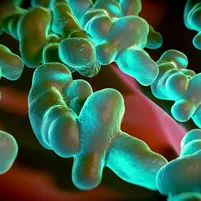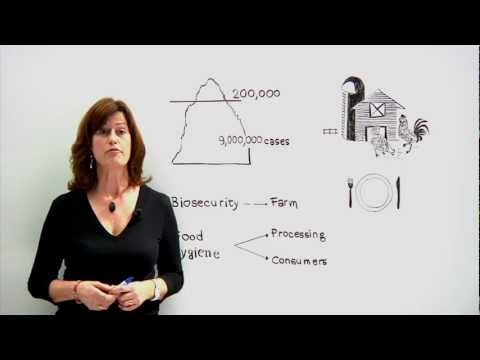Campylobacter


Campylobacter is a bacterium that can cause an illness called campylobacteriosis. With over 246,000 human cases annually, it is the most frequently reported foodborne illness in the EU. However, the actual number of cases is believed to be closer to nine million each year. The cost of campylobacteriosis to public health systems and to lost productivity in the EU is estimated by EFSA to be around €2.4 billion a year.
Campylobacteriosis is a zoonotic disease A zoonotic disease or zoonosis is a disease caused by germs that spread between animals and people – a disease or infection that can be transmitted directly or indirectly between animals and humans.
Usual symptoms are fever, diarrhoea and abdominal cramps. Raw poultry meat is often contaminated with Campylobacter since the bacterium can live in the intestines of healthy birds. It is also found in pigs and cattle. Eating undercooked chicken, or ready-to-eat foods that have been in contact with raw chicken, is the most common source of infection. In its assessments, EFSA has found that chickens and chicken meat may directly account for 20-30% of human cases.
Safe handling of raw meat and other raw food ingredients, thorough cooking and good kitchen hygiene can prevent or reduce the risk posed by contaminated food.
- Fact sheet: EFSA explains zoonotic diseases - Campylobacter
- Five keys to safer food – World Health Organization (WHO)

Latest
In 2022 campylobacteriosis was the most reported zoonosis infectious disease that is transmitted between animals and humans and is caused by harmful microorganisms such as bacteria, viruses, fungi and parasites in the EU, with 137,107 cases and a stable notification rate compared with 2021. See the latest annual EU One Health Zoonoses report by EFSA and ECDC.
EFSA has updated its interactive tools on Campylobacter – a story map and a dashboard. The story map provides general information on Campylobacter, its characteristics and distribution, as well as monitoring activities implemented in the EU. The dashboard allows users to search and query the large amount of data EFSA has collected from EU Member States and other reporting countries since 2017.
Ongoing and completed assessments
Follow EFSA's work
Milestones
2020
April
EFSA experts update and review on-farm control options for Campylobacter in broilers, identifying the most effective ones and assessing the advantages and disadvantages of each measure.
2015
January
In their scientific opinion Opinions include risk assessments on general scientific issues, evaluations of an application for the authorisation of a product, substance or claim, or an evaluation of a risk assessment on public health risks associated with raw milk in the EU, experts from EFSA conclude that raw milk can be a source of harmful bacteria – mainly Campylobacter, Salmonella, and Shiga toxin-producing Escherichia coli STEC).
2011
April
EFSA issues advice on reducing Campylobacter in chicken meat. Recommendations included pre-slaughter measures that could reduce the risk to public health by 50%, meat production measures that could reduce public health risk by 90% or more, and an evaluation of the effectiveness of achieving set reduction targets.
2010
August
EFSA publishes an evaluation of factors that may contribute to the spread of Campylobacter in live chickens and chicken carcasses in the EU. Experts recommend that control programmes be based on an integrated approach that addresses both the chicken farms and the slaughter process. Further studies at national level could also allow better identification of risk factors for Campylobacter infections in each country.
March
Results of a survey on Campylobacter and Salmonella in chicken at slaughterhouses in the European Union show that in most EU Member States a high prevalence The proportion of a population found to have a condition of Campylobacter is found in chickens, whereas Salmonella is less frequently detected. This was EFSA’s sixth baseline survey on foodborne bacteria carried out at EU level and the first to directly investigate the presence of Campylobacter and Salmonella in chickens at slaughter.
January
EFSA issues advice on the extent to which broiler (chicken) meat contributes to human cases of campylobacteriosis. Experts conclude that the handling, preparation and consumption of broiler meat may directly account for 20 to 30% of human cases of campylobacteriosis in the EU.
2007
EFSA’s Task Force on Zoonoses Data Collection proposed a coordinated monitoring programme for Campylobacter in chicken meat in the EU.
2005
April
EFSA publishes an opinion on Campylobacter in animals and foodstuffs which identified poultry meat as a major source of campylobacteriosis.
EFSA's role
To protect consumers from this public health threat, the EU has adopted an integrated approach to food safety from farm to fork. The approach consists of both risk assessment A specialised field of applied science that involves reviewing scientific data and studies in order to evaluate risks associated with certain hazards. It involves four steps: hazard identification, hazard characterisation, exposure assessment and risk characterisation and risk management The management of risks which have been identified by risk assessment. It includes the planning, implementation and evaluation of any resulting actions taken to protect consumers, animals and the environment measures involving all key actors: EU Member States, the European Commission, the European Parliament, EFSA and ECDC. The approach is supported by timely and effective risk communication The interactive exchange of information and opinions throughout the risk analysis process, including the explanation of risk assessment findings and the basis of risk management decisions. The levels of interactive exchange include: the dissemination of public information about risks to consumers or other affected groups; the dialogue within and between risk assessment and risk management; engagement with interested parties affected by risk analysis outcomes..
EFSA plays an important role in protecting consumers from this public health threat by providing independent scientific support and advice on the food safety-related aspects of Campylobacter.
It collects and analyses data on the prevalence of Campylobacter, assesses the risks posed by the bacterium and advising on possible control and mitigation options.
EFSA is assisted by its network on zoonoses monitoring data, a pan-European network of national representatives and international organisations that assist EFSA by gathering and sharing information on zoonoses in their respective countries.
Annual monitoring of Campylobacter in animals and food
EU-wide data on the presence of Campylobacter in the food chain as well as the prevalence of animal and human infection are collected and analysed in annual EU summary reports prepared by EFSA and ECDC. The monitoring data are used with other information to evaluate the progress made in EU Member States in reducing the prevalence of the bacterium.
EU-wide surveys on the prevalence of Campylobacter
EFSA produces baseline survey reports on the prevalence of Campylobacter in food-producing animals such as chickens and on the risk factors that contribute to the prevalence of Campylobacter in animal populations. The findings are used by risk assessors such as EFSA’s Panel on Biological Hazards to provide risk estimates and also by risk managers to define possible control options and/or reduction targets.
Risk assessments and recommendations
EFSA’s Panel on Biological Hazards provides scientific advice on control options at the request of risk managers or on its own initiative. In its assessments, EFSA has among other things found that meeting set reduction targets for Campylobacter in chicken flocks in the EU would significantly reduce the risk of human contamination
EU framework
The monitoring and control of foodborne diseases as well as food hygiene requirements and food safety criteria are regulated by EU legislation. For details on the regulatory framework, see the topic on foodborne zoonotic diseases.